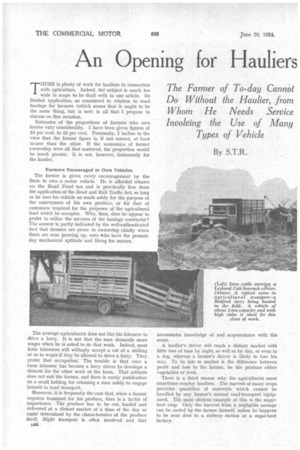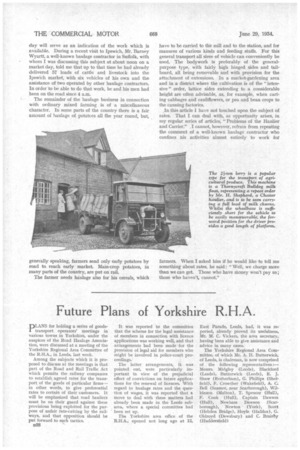An Opening for Hauliers in Agricultural Transport
Page 90

Page 91

Page 92

If you've noticed an error in this article please click here to report it so we can fix it.
The Farmer of To-day Cannot Do Without the Haulier, from Whom He Needs Service Involving the Use of Many Types of Vehicle
By S.T.R.
THERE is plenty of work for hauliers in connection with agriculture. Indeed, thesubject is much too wide in scope to be dealt with in one article. Its limited application, as considered in relation to --road haulage for farmers (which seems that it ought to be the same thing, but is not) is all that I propose to discuss on this occasion.
Estimates of the proportions of farmers who own lorries vary considerably. I have been given figures of 10 per cent. to 50 per cent. Personally, I incline to the view that the former figure is, if not correct, at least nearer than the other. If the economics of farmer ownership were all that mattered, the proportion would be much greater. It is not, however, fortunately for the haulier.
Farmers Encouraged to Own Vehicles.
The farmer is given every encouragement by the State to own a motor vehicle. He is afforded rebates on the Road Fund tax and is practically free from the application of the Road and Rail Traffic Act, so long as he uses his vehicle on roads solely for the purpose of the conveyance of his own produce, or for that of customers required for the purposes of the agricultural land which he occupies. Why, then, does he appear to prefer to utilize the services of the haulage contractor? The answer is partly indicated by the well-authenticated fact that farmers are prone to ownership chiefly when there are sons growing up, sons 'rho have the presentday mechanical aptitude and liking for motors.
The average agriculturist does not like his labourer to drive a lorry. It is not that the man demands more wages when he is asked to do that work. Indeed, most farm labourers will willingly accept a cut of a shilling or so in wages if they be allowed to drive a lorry. They prefer that occupation. The trouble is that once a farm labourer has become a lorry driver he develops a distaste for the other work of the farm. That attitude does not suit the farmer, and there is rarely justification on a small holding for retaining a man solely to engage himself in read transport.
Moreover, it is frequently the case that, when a farmer requires transport for his produce, time is a factor of importance. The produce has to be cut, loaded and delivered at a distant market at a time of the day or night determined by the characteristics of the produce itself. Night transport is often involved and that n36 necessitates knowledge of and acquaintance with the route.
A haulier's driver will reach a distant market with little loss of time by night, as well as by day, or even in a fog, whereas a farmer's driver is likely to lose his way. To be late to market is the difference between profit and loss to the farmer, be the produce either vegetables or fruit.
There is a third reason why the agriculturist must sometimes employ hauliers. The harvest of many crops provides quantities of materials which cannot be handled by any fatiner's normal road-transport equipment. The most obvious example of this is the sugarbeet crop. Only the harvest from a negligible acreage can be carted by the farmer himself, unless he happens to be next door to a railway station or a sugar-beet factory. His cereals, and, often enough, his milk must be carted by a haulier. The conveyance of his cattle and livestock to and from markets, agricultural shows and railway stations is work which the farmer normally prefers to leave to the expert. It is not exaggerating, therefore, to state that the haulage contractor is indispensable to the farmer.
With the haulage of sugar-beet I have dealt from time to -time in these columns. It is the biggest department of agricultural road transport and is still growing. I am informed that next year's crop is likely to beat all records and that, in order to deal with it, the season will probably be extended from earloy in September to the beginning of February. The vehicle best suited for the work should have a capacity of not less than six tons. Users of small vehicles make a profit only in exceptional cases, and hinder others.
Special Requirements in Bodywork.
The bodies must be high, having hinged and detachable sides and tailboards, with removable extensions. It is advisable to provide rope-netting covers to prevent the beet from tumbling to the ground.
Next in order of importance comes the conveyance of cattle and livestock. Here a special type of vehicle is necessary. It must comply with the requirements of the law, in that it must be capable of being covered so as to protect the animals from the elements ; there must be no wheel-arches or other projections against which the animals might hurt themselves. The floor must be slatted, or well covered with a good depth of straw, day will serve as an indication of the work which is available. During a recent visit to Ipswich, Mr. Barney Wyartt, a well-known haulage contractor in Suffolk, with whom I was discussing this subject at about noon on a. market day, told me that up to that time he had already delivered 57 loads of cattle and livestock into the Ipswich market, with six vehicles of his own and the assistance of two operated by other haulage contractors. In order'to be able to do that work, he and his men had been on the road since 4 a.m.
The remainder of the haulage business in connection with ordinary mixed farming is of a miscellaneous character. In some parts of the country there is a fair amount of haulage of potatoes all the year round, but, generally speaking, farmers send only early potatoes by road to reach early market. Main-crop potatoes, in many parts of the country, are put on rail.
The farmer needs haulage also for his cereals, which
have to be carried to the mill and to the station, and for manures of various kinds and feeding stuffs. For this general transport all sizes of vehicle can conveniently be used. The bodywork is preferably of the generalpurpose type, with fairly high hinged sides and tailboard, all being removable and with provision for the attachment of extensions. In a market-gardening area and in a district where the cultivation is of the " intensive " order, lattice sides extending to a considerable height are often advisable, as, for example, when carting cabbages and cauliflowers, or pea and bean crops to the canning factories.
In this article I have not touched upon the subject of rates. That I can deal with, as opportunity arises, in my regular series of articles, "Problems of the Haulier and Carrier." I cannot, however, refrain from repeating the comment of a well-known haulage contractor who confines his activities almost entirely to work for farmers. When I asked him if he would like to tell me something about rates, he said : "Well, we charge more than we can get. Those who have Money won't pay us ; those who haven't, cannot."
































































































































































